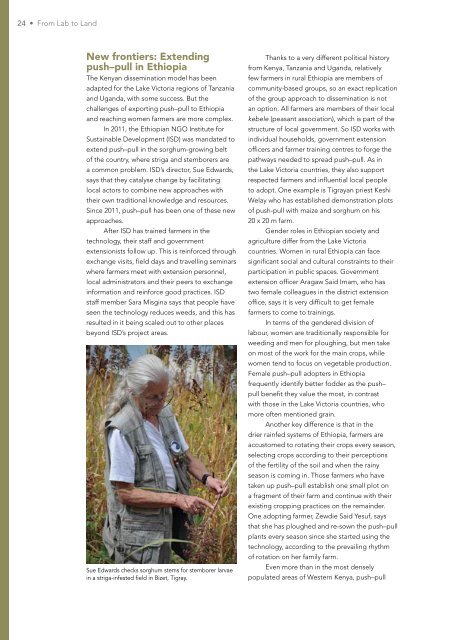to Land
women_in_push-pull
women_in_push-pull
You also want an ePaper? Increase the reach of your titles
YUMPU automatically turns print PDFs into web optimized ePapers that Google loves.
24 • From Lab <strong>to</strong> <strong>Land</strong><br />
New frontiers: Extending<br />
push–pull in Ethiopia<br />
The Kenyan dissemination model has been<br />
adapted for the Lake Vic<strong>to</strong>ria regions of Tanzania<br />
and Uganda, with some success. But the<br />
challenges of exporting push–pull <strong>to</strong> Ethiopia<br />
and reaching women farmers are more complex.<br />
In 2011, the Ethiopian NGO Institute for<br />
Sustainable Development (ISD) was mandated <strong>to</strong><br />
extend push–pull in the sorghum-growing belt<br />
of the country, where striga and stemborers are<br />
a common problem. ISD’s direc<strong>to</strong>r, Sue Edwards,<br />
says that they catalyse change by facilitating<br />
local ac<strong>to</strong>rs <strong>to</strong> combine new approaches with<br />
their own traditional knowledge and resources.<br />
Since 2011, push–pull has been one of these new<br />
approaches.<br />
After ISD has trained farmers in the<br />
technology, their staff and government<br />
extensionists follow up. This is reinforced through<br />
exchange visits, field days and travelling seminars<br />
where farmers meet with extension personnel,<br />
local administra<strong>to</strong>rs and their peers <strong>to</strong> exchange<br />
information and reinforce good practices. ISD<br />
staff member Sara Misgina says that people have<br />
seen the technology reduces weeds, and this has<br />
resulted in it being scaled out <strong>to</strong> other places<br />
beyond ISD’s project areas.<br />
Sue Edwards checks sorghum stems for stemborer larvae<br />
in a striga-infested field in Bizet, Tigray.<br />
Thanks <strong>to</strong> a very different political his<strong>to</strong>ry<br />
from Kenya, Tanzania and Uganda, relatively<br />
few farmers in rural Ethiopia are members of<br />
community-based groups, so an exact replication<br />
of the group approach <strong>to</strong> dissemination is not<br />
an option. All farmers are members of their local<br />
kebele (peasant association), which is part of the<br />
structure of local government. So ISD works with<br />
individual households, government extension<br />
officers and farmer training centres <strong>to</strong> forge the<br />
pathways needed <strong>to</strong> spread push–pull. As in<br />
the Lake Vic<strong>to</strong>ria countries, they also support<br />
respected farmers and influential local people<br />
<strong>to</strong> adopt. One example is Tigrayan priest Keshi<br />
Welay who has established demonstration plots<br />
of push-pull with maize and sorghum on his<br />
20 x 20 m farm.<br />
Gender roles in Ethiopian society and<br />
agriculture differ from the Lake Vic<strong>to</strong>ria<br />
countries. Women in rural Ethiopia can face<br />
significant social and cultural constraints <strong>to</strong> their<br />
participation in public spaces. Government<br />
extension officer Aragaw Said Imam, who has<br />
two female colleagues in the district extension<br />
office, says it is very difficult <strong>to</strong> get female<br />
farmers <strong>to</strong> come <strong>to</strong> trainings.<br />
In terms of the gendered division of<br />
labour, women are traditionally responsible for<br />
weeding and men for ploughing, but men take<br />
on most of the work for the main crops, while<br />
women tend <strong>to</strong> focus on vegetable production.<br />
Female push–pull adopters in Ethiopia<br />
frequently identify better fodder as the push–<br />
pull benefit they value the most, in contrast<br />
with those in the Lake Vic<strong>to</strong>ria countries, who<br />
more often mentioned grain.<br />
Another key difference is that in the<br />
drier rainfed systems of Ethiopia, farmers are<br />
accus<strong>to</strong>med <strong>to</strong> rotating their crops every season,<br />
selecting crops according <strong>to</strong> their perceptions<br />
of the fertility of the soil and when the rainy<br />
season is coming in. Those farmers who have<br />
taken up push–pull establish one small plot on<br />
a fragment of their farm and continue with their<br />
existing cropping practices on the remainder.<br />
One adopting farmer, Zewdie Said Yesuf, says<br />
that she has ploughed and re-sown the push–pull<br />
plants every season since she started using the<br />
technology, according <strong>to</strong> the prevailing rhythm<br />
of rotation on her family farm.<br />
Even more than in the most densely<br />
populated areas of Western Kenya, push–pull


